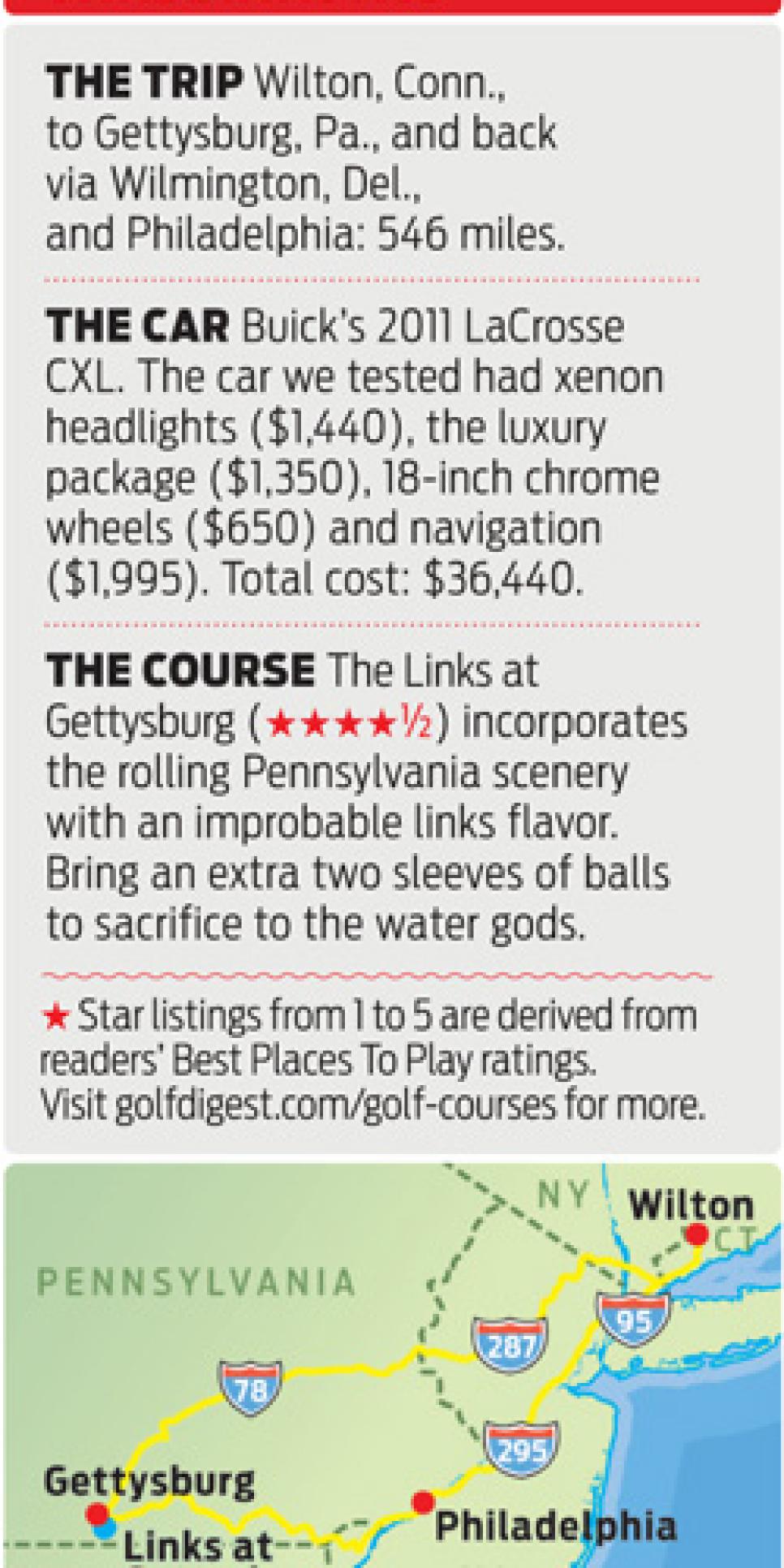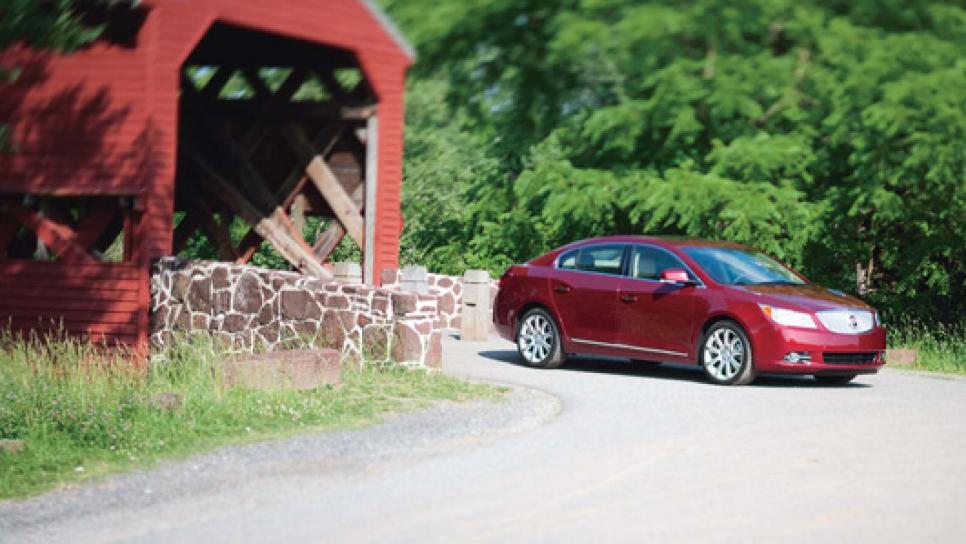Courses
Long Drives: Wilton To Gettysburg In A 2011 Buick Lacrosse CXL

The Links at Gettysburg.
I'm sure I'm not the only one who hooted when Tiger Woods
signed his mega-endorsement deal with Buick in 1999. It was hard to say which was more improbable -- that oldsters interested in Buick's land yachts would be swayed by a pitch from a wealthy 23-year-old golfer, or that a wealthy 23-year-old golfer would actually have a Park Avenue or a Rendezvous in his driveway.
We know how the story ended for Tiger and GM: They broke up, literally and figuratively. But obscured by the publicity vortex surrounding its ex has been Buick's renaissance as a legitimate luxury brand for people not yet eligible for Social Security.
The pointy end of Buick's triple spear has been aimed at younger, upwardly mobile buyers -- conquests from Japanese and German brands. After spending three days in the new LaCrosse driving from Connecticut to the Civil War battlefields in Gettysburg, Pa., it's clear Buick can drop the inferiority complex. The LaCrosse is worth a cross-shop with the Lexus ES, and loaded it comes in thousands lower on the sticker.

Buick's demographic image isn't the only thing that has been retooled. Our deep-maroon test car was outfitted with Buick's new 182-horsepower, four-cylinder engine -- sacrilege for loyalists who remember the hairy GS 455 big blocks of the early 1970s. But boomer offspring have more appreciation for dramatically improved interior-finish quality, a modern radio interface, extra power outlets and the 30 highway miles per gallon the LaCrosse gets over dominant quarter-mile times.
The sedate Buick chewed up some 135 miles of I-78 in silence, and we reached the outskirts of Gettysburg at noon on a scorching-hot late-summer day. Stepping from the air-conditioned, leather-wrapped cocoon near Little Round Top, scene of some of the fiercest fighting during the July 1863 battle, it's nearly impossible to comprehend what happened here, in the same blazing weather 147 years ago. After marching 20 miles that day with little water, Confederate troops advanced to take the hill held by four Union regiments. The Union soldiers initially repelled the Southern push and then, out of ammunition, countered with a desperate bayonet charge to hold the hill. More than 1,600 men on both sides were killed or wounded in a few hours in this little corner of the battle.
The National Park Service has blocked off most of the Gettysburg battlefield and paved a series of roads through it, making it easy to follow the flow of the action. The roads are lined with cannons from the conflict and monuments immortalizing the various state regiments from both sides that participated in the fight.
Many historical battle sites (like the Alamo in San Antonio) have had their authenticity re-created away. Fortunately, Gettysburg has been preserved in stark, natural form. It isn't hard to picture human, animal and mechanical casualties strewn around the stubbled, rocky Devil's Den, or at the Cemetery Hill promontory.
The drive up Steinwehr Avenue into town is an exercise in time travel. You can eat lunch at the Dobbin House Tavern, built in 1776 as a private home and used as a field hospital during the war, then dress in Union or Confederate gear and have a vintage wet-plate photograph taken by Del Hilbert at the Victorian Photography Studio across the street. The only catch? Staying still in an itchy cotton officer's tunic for the 20 seconds the silver-nitrate plate takes to receive the exposure. That and keeping well clear of the cyanide liquid Hilbert uses to fix the image at the end. When he says don't touch, he's not kidding.
Just south of the battlefield -- on the aptly named Mason Dixon Road, just before you get to Dixie, er, Maryland -- is the Links at Gettysburg
, which opened in 1999. Set in the same rolling, tree-lined terrain that made the battle up the road so harrowing, the Lindsay Ervin-Steve Klein design calls itself a "European-style links," complete with heather and pot bunkers. But the grass is way too lush, the cartpaths too prominent, and the ocean too far away, for that classification.
The case of mistaken identity doesn't do anything to detract from the playing experience, though. We paid $58 each for 18 holes and a cart and were thoroughly entertained -- and occasionally befuddled -- by our rambling run over the 7,069-yard course. Every hole on the back has the potential for you to get wet, culminating in a stretch from 15 to 18 that requires 800 yards of combined forced carry off the tee. The par-3 15th plays 236 yards from the back tees to a 50-yard-deep, three-tiered green. Soft pitching wedge was the right call for my second shot from the front-left corner of the green to the back-left flag, but a glare from my partner shamed me into whacking a putt up 30 feet short and taking bogey. The approach shot on 16, a 493-yard par 4, has you wishing you pulled one of the artillery pieces from the national park with you behind the cart. It's uphill over a creek to a green with a fierce tier cutting across its middle. From 235 yards, it was either a career 5-wood or a lay-up for me. I laid up. Gen. Pickett would have been gravely disappointed.
Sweaty and tired, we drove back into town and stopped at Gettysburg Eddie's for a cold Yuengling and a double-header cheeseburger -- and a round of catcalls for the geographically inappropriate Detroit Tigers cap on my head. Bar namesake Eddie Plank, a Gettysburg native and Hall of Fame pitcher for the Philadelphia Athletics in the 1900s, wouldn't have known what to make of the big-screen televisions, but he would have felt right at home.

__ You can almost hear the clatter of soldiers' boots across the Sachs Covered Bridge in Gettysburg, Pa. (Photo by Bob Scott)__

